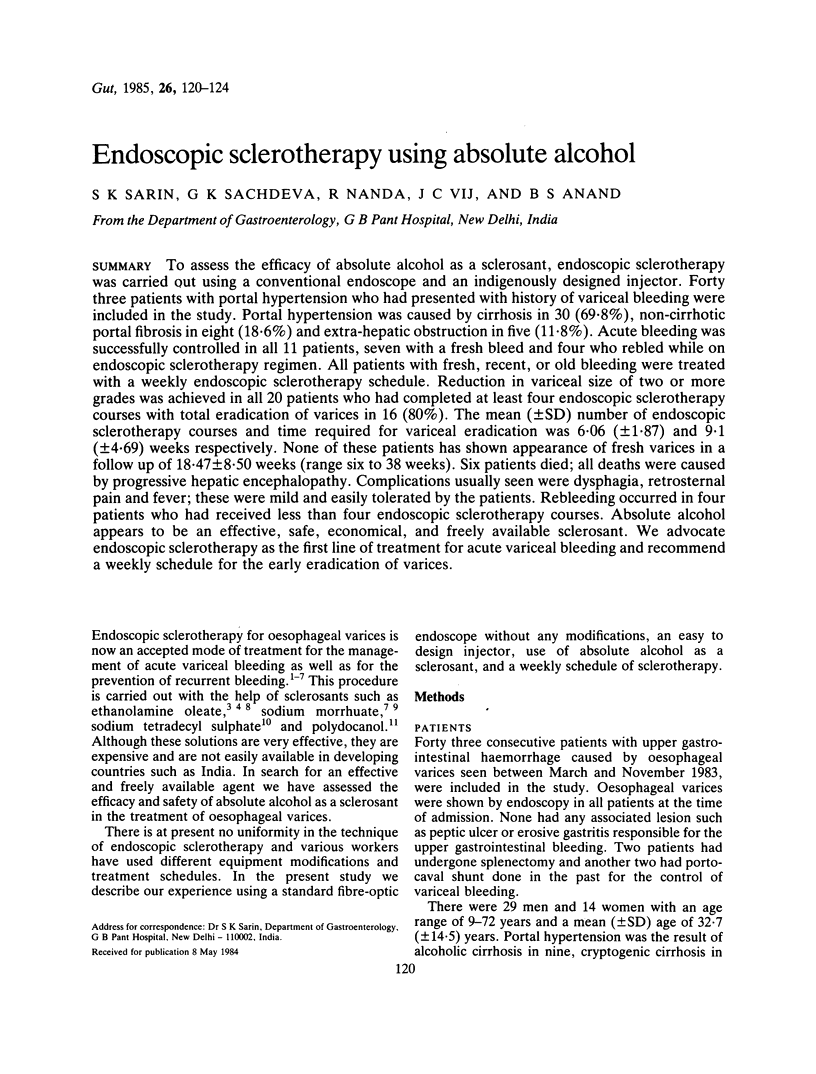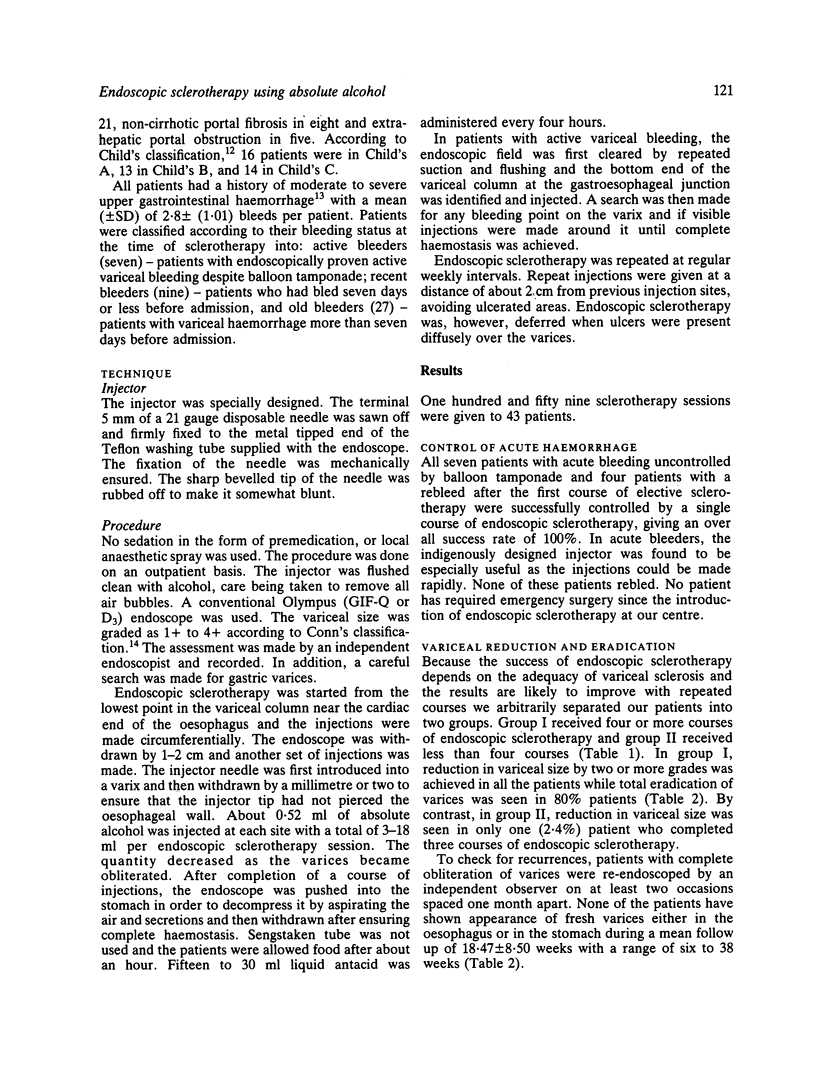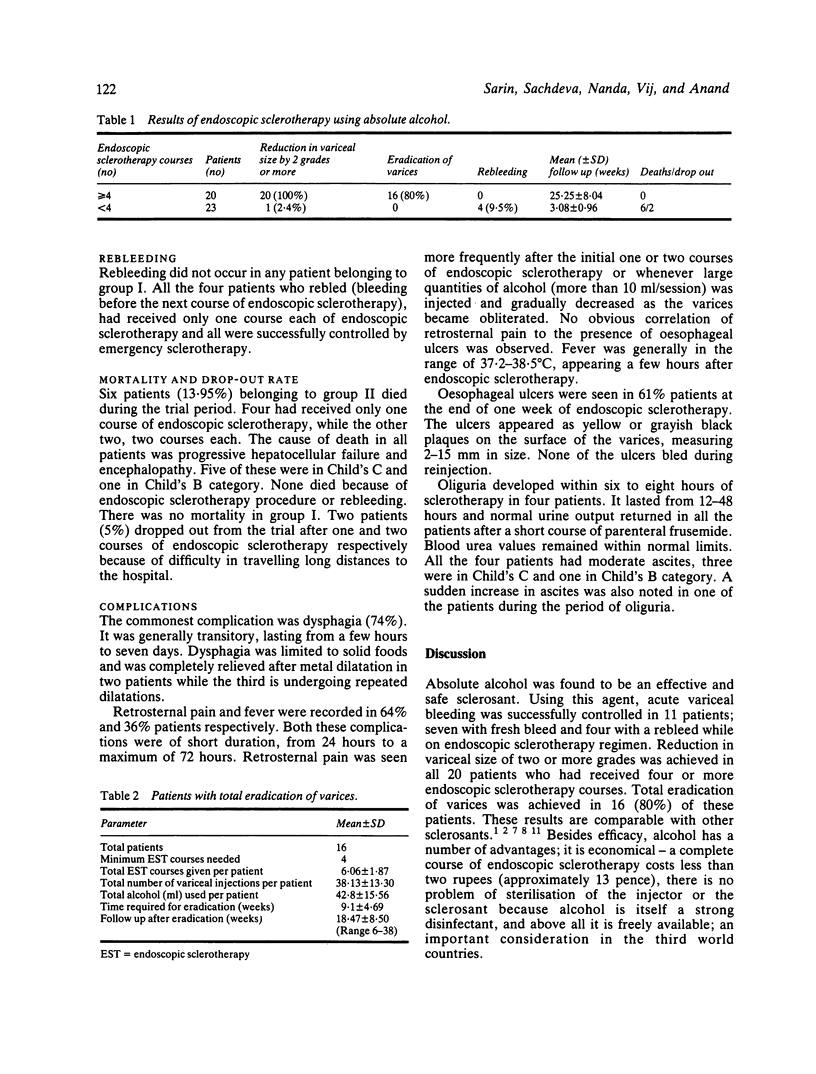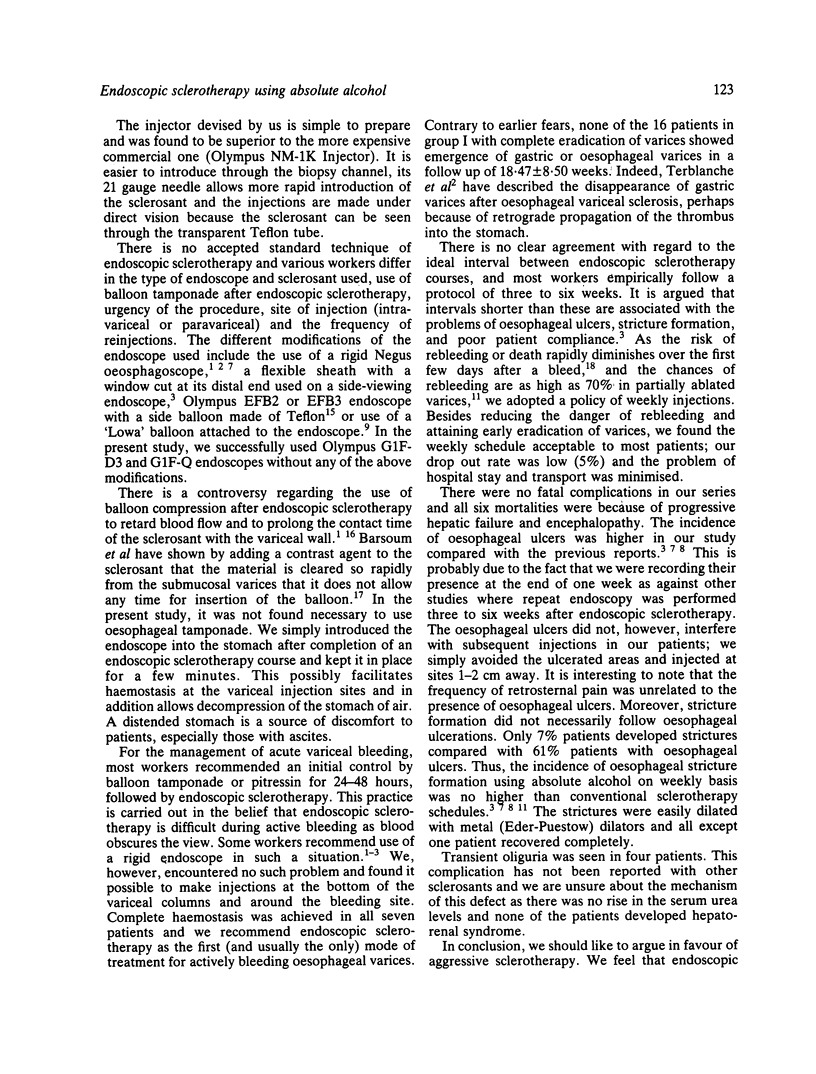Abstract
To assess the efficacy of absolute alcohol as a sclerosant, endoscopic sclerotherapy was carried out using a conventional endoscope and an indigenously designed injector. Forty three patients with portal hypertension who had presented with history of variceal bleeding were included in the study. Portal hypertension was caused by cirrhosis in 30 (69.8%), non-cirrhotic portal fibrosis in eight (18.6%) and extra-hepatic obstruction in five (11.8%). Acute bleeding was successfully controlled in all 11 patients, seven with a fresh bleed and four who rebled while on endoscopic sclerotherapy regimen. All patients with fresh, recent, or old bleeding were treated with a weekly endoscopic sclerotherapy schedule. Reduction in variceal size of two or more grades was achieved in all 20 patients who had completed at least four endoscopic sclerotherapy courses with total eradication of varices in 16 (80%). The mean (+/- SD) number of endoscopic sclerotherapy courses and time required for variceal eradication was 6.06 (+/- 1.87) and 9.1 (+/- 4.69) weeks respectively. None of these patients has shown appearance of fresh varices in a follow up of 18.47 +/- 8.50 weeks (range six to 38 weeks). Six patients died; all deaths were caused by progressive hepatic encephalopathy. Complications usually seen were dysphagia, retrosternal pain and fever; these were mild and easily tolerated by the patients. Rebleeding occurred in four patients who had received less than four endoscopic sclerotherapy courses. Absolute alcohol appears to be an effective, safe, economical, and freely available sclerosant. advocate endoscopic sclerotherapy as the first line of treatment for acute variceal bleeding and recommend a weekly schedule for the early eradication of varices.
Full text
PDF




Selected References
These references are in PubMed. This may not be the complete list of references from this article.
- Barsoum M. S., Khattar N. Y., Risk-Allah M. Z. Technical aspects of injection sclerotherapy of acute oesophageal variceal haemorrhage as seen by radiography. Br J Surg. 1978 Aug;65(8):588–589. doi: 10.1002/bjs.1800650819. [DOI] [PubMed] [Google Scholar]
- Child C. G., Turcotte J. G. Surgery and portal hypertension. Major Probl Clin Surg. 1964;1:1–85. [PubMed] [Google Scholar]
- Clark A. W., Macdougall B. R., Westaby D., Mitchell K. J., Silk D. B., Strunin L., Dawson J. L., Williams R. Prospective controlled trial of injection sclerotherapy in patient with cirrhosis and recent variceal haemorrhage. Lancet. 1980 Sep 13;2(8194):552–554. doi: 10.1016/s0140-6736(80)91990-x. [DOI] [PubMed] [Google Scholar]
- Conn H. O. Ammonia tolerance in the diagnosis of esophageal varices. A comparison of endoscopic, radiologic, and biochemical techniques. J Lab Clin Med. 1967 Sep;70(3):442–451. [PubMed] [Google Scholar]
- Conn H. O. Endoscopic sclerotherapy: an analysis of variants. Hepatology. 1983 Sep-Oct;3(5):769–771. doi: 10.1002/hep.1840030526. [DOI] [PubMed] [Google Scholar]
- Garden O. J., Osborne D. H., Blamey S. L., Carter D. C. The management of acute variceal haemorrhage. Aust N Z J Surg. 1983 Jun;53(3):197–202. doi: 10.1111/j.1445-2197.1983.tb02428.x. [DOI] [PubMed] [Google Scholar]
- Goodale R. L., Silvis S. E., O'Leary J. F., Gebhard R., Mjollness L., Johnson M., Fryd D. Early survival after sclerotherapy for bleeding esophageal varices. Surg Gynecol Obstet. 1982 Oct;155(4):523–528. [PubMed] [Google Scholar]
- Hughes R. W., Jr, Larson D. E., Viggiano T. R., Adson M. A., van Heerden J. A., Reeves C. B. Endoscopic variceal sclerosis: a one-year experience. Gastrointest Endosc. 1982 May;28(2):62–66. doi: 10.1016/s0016-5107(82)72999-2. [DOI] [PubMed] [Google Scholar]
- Kirkham J. S., Quayle J. B. Oesophageal varices: evaluation of injection sclerotherapy without general anesthesia using the flexible fibreoptic gastroscope. Ann R Coll Surg Engl. 1982 Nov;64(6):401–405. [PMC free article] [PubMed] [Google Scholar]
- Kjaergaard J., Fischer A., Miskowiak J., Lindahl F., Baden H. Sclerotherapy of bleeding esophageal varices. Long-term results. Scand J Gastroenterol. 1982 Apr;17(3):363–367. doi: 10.3109/00365528209182068. [DOI] [PubMed] [Google Scholar]
- Lewis J., Chung R. S., Allison J. Sclerotherapy of esophageal varices. Arch Surg. 1980 Apr;115(4):476–480. doi: 10.1001/archsurg.1980.01380040098017. [DOI] [PubMed] [Google Scholar]
- Pickard R. G., Sanderson I., South M., Kirkham J. S., Northfield T. C. Controlled trial of cimetidine in acute upper gastrointestinal bleeding. Br Med J. 1979 Mar 10;1(6164):661–662. doi: 10.1136/bmj.1.6164.661-a. [DOI] [PMC free article] [PubMed] [Google Scholar]
- Sivak M. V., Jr, Stout D. J., Skipper G. Endoscopic injection sclerosis (EIS) of esophageal varices. Gastrointest Endosc. 1981 May;27(2):52–57. doi: 10.1016/s0016-5107(81)73148-1. [DOI] [PubMed] [Google Scholar]
- Smith J. L., Graham D. Y. Variceal hemorrhage: a critical evaluation of survival analysis. Gastroenterology. 1982 May;82(5 Pt 1):968–973. [PubMed] [Google Scholar]
- Takase Y., Ozaki A., Orii K., Nagoshi K., Okamura T., Iwasaki Y. Injection sclerotherapy of esophageal varices for patients undergoing emergency and elective surgery. Surgery. 1982 Sep;92(3):474–479. [PubMed] [Google Scholar]
- Terblanche J., Yakoob H. I., Bornman P. C., Stiegmann G. V., Bane R., Jonker M., Wright J., Kirsch R. Acute bleeding varices: a five-year prospective evaluation of tamponade and sclerotherapy. Ann Surg. 1981 Oct;194(4):521–530. doi: 10.1097/00000658-198110000-00015. [DOI] [PMC free article] [PubMed] [Google Scholar]
- Westaby D., Macdougall B. R., Melia W., Theodossi A., Williams R. A prospective randomized study of two sclerotherapy techniques for esophageal varices. Hepatology. 1983 Sep-Oct;3(5):681–684. doi: 10.1002/hep.1840030509. [DOI] [PubMed] [Google Scholar]


